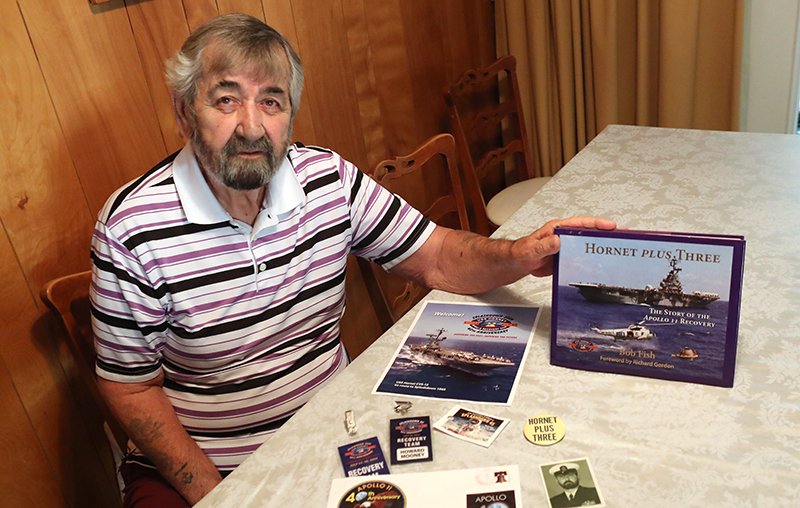The 50th anniversary of the splashdown of Apollo 11 will be commemorated this week and one Hot Springs native had a "ringside seat" for the event.
Howard Mooney served as senior quartermaster on the enlisted side on the USS Hornet, and every five years he and the crew get together to celebrate the anniversary of the event.
The ship is moored at Alameda, Calif., and has been restored and is now a museum, Mooney said.
"I was the senior quartermaster -- which is navigator -- of the enlisted side, and I had 18 people that worked for me. Above me was the assistant navigator and the navigator. Four or five of them are dead ... but we all go, whoever can. There's normally eight or 10 of us that will show up, plus all the other departments that were on the ship. ... There will be 500 or 600 people there," he said.
Buzz Aldrin, who was on the crew of Apollo 11 with the late Neil Armstrong and Michael Collins, has attended the splashdown anniversary the last two or three times it has been held, Mooney said. While he did not meet Aldrin aboard, Mooney said he has since met him.
Mooney said this year he will take his son, Josh, and granddaughter, Kami, with him, and is excited to share the historic event with them.
"I had a ringside seat because I worked on the bridge where the captain and plotting tables (were), the wheel where the guy's driving it," he said. "I was in charge of training all the other departments who provided helmsmen while you were at sea. When we went in and out of port or if we had a special evolution like we were going to anchor, or we had an oiler or ammunition ship come alongside, that was special. So my people manned all of these stations.
"When we were selected for Apollo 11, then we started practicing with a dummy capsule ... and we'd put it in the water and we would practice approaching it, putting a collar on it and so forth. We did that for a month or so. Then we went to Hawaii to get ready for it. The only navigation that we had was celestial -- the stars, the sun, the moon and the planets. Once you left land, you were on your own."
Mooney said about two days before splashdown, the Hornet ran into some issues south of the equator as cloudy skies made it difficult to "shoot stars" and find their position.
"You can't shoot stars if it's cloudy," he said. "So, we moved around 50 miles or so back and forth trying to find an opening. The weather people were working with us trying to say 'Well, where are we going to be able to pull this off at?' So we did that for two days.
"The morning of splashdown we had already precomputed where we thought we were and we could use that as an estimate and we went up and shot stars about 15 minutes before splashdown. I got two, which is an (estimated position), the assistant navigator got two and the navigator got one. At the time that we plotted, we figured we were about 12 miles west of where we should be and (the navigator's) line put us at 5 miles. They wanted to be there so we hauled a - - going that way and we saw it coming in. We saw it when it opened -- the parachutes -- but we weren't there yet."
When the astronauts came aboard, Mooney said they were kept in a trailer in quarantine for the two to three days it took the ship to return to Hawaii.
"They had on contamination suits because they didn't know if they were going to be contaminated or not," he said. "They were taken down below and put in a trailer and kept them in quarantine until we got back to Hawaii. Then they were lifted in this trailer off with a crane and put on a big C-130, and they flew them back to Houston, I think, and took them out."
The astronauts "had a doctor in there with them, running tests all that time. They had a window here that they would open every couple of hours so you could walk by and say 'hello' to them or wave at them."
When the astronauts came aboard, large canisters of film from their trek to the moon were immediately flown to get developed.
"All the film that they brought back from the moon was in canisters and a big balloon that looked like a fish went up, and this plane that had forks on it came flying over and caught below the balloon, shot them up off the deck," Mooney said. "Their back door was open and they reeled it in and then they flew them right away so they could develop (the photos). ... It was just a faster way without them having to wait two or three days for us to get back to Hawaii."
Because of the success the Hornet saw with the splashdown of Apollo 11, Mooney said the ship was contracted for Apollo 12, as well. Both events were met with excitement by the crew.
"They had four or five different ships that they could have picked," he said. "For Apollo 8 and Apollo 7, where they just orbited, they used other ships. But when we got finished with Apollo 11 they said 'You've done such a good job with 11, we want you to go back and do 12.' So we did that."
Local on 07/20/2019